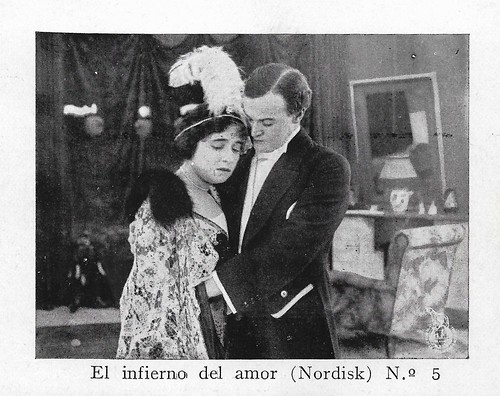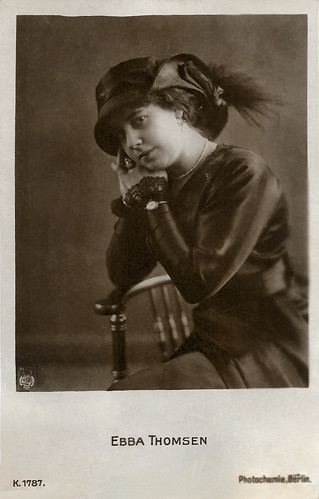
German postcard by Verlag Hermann Leiser, Berlin, no. 5651.

German postcard by Verlag Hermann Leiser, Berlin, no. 7280. Olaf Fönss and Ebba Thomsen in Verdens Undergang/The end of the world (August Blom, 1916), released in Germany as Das jüngste Gericht.

German postcard by Verlag Hermann Leiser, Berlin, no. 7281. Olaf Fønss and Ebba Thomsen in Verdens Undergang/The end of the world (August Blom, 1916).

German postcard by Verlag Hermann Leiser, Berlin, no. 5299.
An absolute sense of style
Ebba Ove Thomsen was born in 1887 in Copenhagen, Denmark, as the daughter of one of the leading fashion designers of the time. Thomsen later credited her father with giving her "an absolute sense of style. I knew precisely how every fabric should look on me, whether it was a princess' gown or a washerwoman's rags."
She made her stage debut at Det Ny Teater in 1910 and began filming in 1912 at Nordisk Film. From the beginning to the early 1920s, she was one of the most used actresses of the time and appeared in about 75 films - the majority as the lead actress.
Just like her female colleagues Clara Wieth and Else Frölich, she achieved film star status in Denmark, particularly while working with Nordisk Film's biggest male film star Valdemar Psilander, e.g. in Den sorte kansler/The black chancellor (August Blom, 1912), Den glade løjtnant/When Bacchus Reigns (Robert Dinesen, 1912), and Arbejdet adler/A Master of Men (Robert Dinesen, 1914).
In a newspaper interview for her 50th birthday, Ebba Thomsen said that her "unique success depended on two things: "First, that Psilander and I suited one another. I was actually a little too tall for him, yet our types suited each other, our movements, our acting. In short, we were a born 'film-couple'."
Thomsen was also paired with Robert Dinesen in such films as Guvernørens datter/The Governor's Daughter (August Blom, 1912) and Den tredie magt/The Stolen Treaty (August Blom, 1913) and with Olaf Fönss in Atlantis (August Blom, 1913), Den mystiske Fremmede/A Deal with the Devil (Holger-Madsen 1914), and Verdens Undergang/The End of the World (August Blom, 1916). She also co-starred with Gunnar Tolnaes, Alf Blütecher, Einar Zangenberg, and Svend Kornbeck.

Spanish minicard, no. 1. Ebba Thomsen and Nicolai Johannsen in Et kaerlighedsoffer/I will repay (Robert Dinesen, 1914), released in Spain as El infierno del amor.

Spanish minicard, no. 2. Ebba Thomsen and Thorkild Roose in Et kaerlighedsoffer/I will repay (Robert Dinesen, 1914), released in Spain as El infierno del amor.

Spanish minicard, no. 3. Ebba Thomsen in Et kaerlighedsoffer/I will repay (Robert Dinesen, 1914), released in Spain as El infierno del amor.

Spanish minicard, no. 4. Ebba Thomsen, Nicolai Johannsen and Thorkild Roose in Et kaerlighedsoffer/I will repay (Robert Dinesen, 1914), released in Spain as El infierno del amor.

Spanish minicard, no. 5. Ebba Thomsen and Nicolai Johannsen in Et kaerlighedsoffer/I will repay (Robert Dinesen, 1914), released in Spain as El infierno del amor.

Spanish minicard, no. 6. Ebba Thomsen and Nicolai Johannsen in Et kaerlighedsoffer/I will repay (Robert Dinesen, 1914), released in Spain as El infierno del amor.
Usually cast as princesses, countesses, or artists
Ebba Thomsen was directed by August Blom in many of her films in 1912. From 1913 on, it was Robert Dinesen who directed most of her films. In the early 1920s, Fritz Magnussen often directed her. Thomsen was usually cast as princesses, countesses, or artists.
In 1915 Thomsen married the Norwegian actor Thorleif Brinch Lund, with whom she had acted in I Farens Stund/In Father's Time (Robert Dinesen, 1915). In 1917, she left Nordisk Film and traveled with her husband to Norway, where they ran a touring company, but without much success.
In 1920 Thomsen returned to Denmark and cinema and recorded a number of films for Astra film with director Fritz Magnussen. In 1924 she recorded the last two films for Nordisk film and then withdrew from the film in 1925.
In 1930 she performed one last time at the Dagmarteatret. In 1952, she returned briefly to record her only sound film, Husmandstøsen/The Housewife (Alice O'Fredericks, 1952). She was then 65 years old.
Ebba Thomsen died in 1973 in Copenhagen, at the age of 86. She is buried in Gentofte Cemetery.

Spanish postcard by Union Postal Universal. Photo: Nordisk. Caption: Artista de la casa Nordisk. The name of the actress is misspelled.

German postcard by Photochemie, Berlin, no. K. 1787. Photo: Nordisk.

German postcard by Photochemie, Berlin, no. K. 1788. Photo: Nordisk.

German postcard by Photochemie, Berlin, no. K. 1916. Photo: Nordisk Films. Valdemar Psilander and Ebba Thomsen in Das zweite Ich, German release title for Lykken/The Road to Happiness (Holger-Madsen, 1918).

German postcard by Verlag Hermann Leiser, Berlin, no. 5030.
Sources: Danish Film Database, Wikipedia (English and Danish), and IMDb.
No comments:
Post a Comment